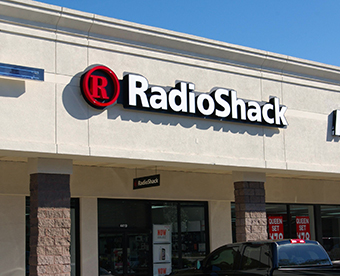
Radio Shack’s Hard Times
| published January 19, 2015 |
By Thursday Review staff
Radio Shack’s slow business demise has been both predictable and—some would argue—probably inevitable. Though its coming meltdown was not as obvious as the business model collapses of, say Blockbuster or My Space, it has nevertheless suffered from a remarkable lack of flexibility and adaptability over the last two decades.
Its very name has a musty, dusty, garage-like scent to it: “radio” and “shack,” terms which were in fact already a throwback to a distant age by the time we trundled through the early 1980s and were already casting off the memories of when devices had “tubes” in them, and ham radio enthusiasts sometimes broadcast or listened in small “shacks.” In fact, the store name was chosen in 1921 by its founders, Ted and Milton Deutschmann, who borrowed the term from the U.S. Navy parlance for the small communications rooms atop ships. The company started printing full-scale catalogues in 1939, began selling its own brands of gadgets under the name Realistic in the 1950s, and was already selling personal computers by the mid-1970s. By 1974, Radio Shack was the largest seller of small batteries—in the world.
Radio Shack’s once-powerful business model was inescapable: once upon a time, when you needed that certain electronic part or that specific battery, you made the short drive to your neighborhood Shack and—usually within minutes and with very little fanfare—you had what you needed. Never known to be inexpensive, Radio Shack won over loyalty by being customer service-friendly, well-stocked, and readily available when one needed a package of “C” batteries for an analog tape recorder, a beige spiral windy-cord for the kitchen wall phone, or a circuit board for the electric train set. In the age when we called such things “electronics” and not “technology,” Radio Shack was the go-to place.
The stores are bright and clean, generally well-positioned geographically, and the employees relentlessly helpful and polite. What’s not to like about a place where you can dash to at 3:20 on a Saturday afternoon—when Wal-Mart, Target, and Best Buy are packed wall-to-wall with mayhem—because you need a thingamajig which connects your HP laptop to your Samsung voice-activated audio recorder (been there, done that).
But now, like its kindred spirit Blockbuster, Radio Shack is in the last stages of meltdown, and there is little the venerable company can do to halt the decline. Some business and technology analysts predict that its value will fall so low as to make it vanish within the next 24 months. And like Blockbuster, even its vast inventory will become nearly worthless. Radio Shack finds it can no longer compete with online retailers of electronics and technology, especially Amazon.
The Fort Worth-based Radio Shack, which attempted last year to stave off collapse by rapidly shuttering a thousand underperforming retail locations, has been unable to halt the decline, and it is now facing bankruptcy. It may file officially as early as February 1, 2015. Depending on the terms chosen and agreed upon by the courts, Radio Shack could then receive protection from its creditors while it reorganizes and restructures. Under the proposed terms, Radio Shack would shut down about 1000 stores, but would continue to operate approximately 2500 to 2900 stores in North America.
One of Radio Shack’s possible solutions, discussed under its pending bankruptcy filings, is to sell off a significant share of its retail locations to wireless provider Sprint, though it is not clear on whether the sale would mean Sprint would operate the stores as electronic locations, or if Sprint would simply acquire the leases for those retail spaces.
Though neither Radio Shack nor Sprint will comment directly on the rumors, statements by both companies seem to indicate that a deal is close. Sprint CEO Marcelo Claure recently told an audience of CitiGroup investors that the wireless giant planned to add a significant number of new retail locations in 2015, and it has already begun to develop marketing plans which include the promotion of hundreds of new retail locations. His remarks align neatly with remarks made by some within Radio Shack which say the company plans to recoup what it can from long-term and short-term retail leases. At its peak, Radio Shack operated some 6000 stores in the United States alone, making it one of the biggest retailers anywhere, based on store front locations.
Related Thursday Review articles:
Radio Shack's Image Deficit; Thursday Review staff; Thursday Review; March 4, 2014
